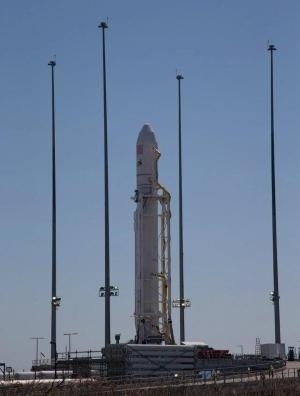Tue, Jan 07, 2014
Company’s Engineering Team At NASA’s Wallops Flight Facility Helps Boost Reliability Of Space Agency’s Sounding Rocket Program To Record Levels
Orbital Sciences Corporation says that its NASA Sounding Rocket Operations Contract II (NSROC II) team at Wallops Island, Virginia recently completed its 40th consecutive successful mission over the last 24 months for NASA’s Sounding Rocket Program (NSRP). Orbital began operations as the NSROC II prime contractor in October 2010 and has completed a total of 57 missions in the last three years.

The NASA program performs suborbital launch missions in support of astronomy, geophysics, space physics, and Earth and planetary science investigations for NASA's science disciplines. Science and engineering research missions are also conducted for NASA centers and the Department of Defense. Recent missions include the successful Far-UV imaging of the Comet C/ISON and a high-resolution spectrum survey of the atmosphere of Venus.
The NSROC II program offers a practical and cost-effective method to develop and refine space science technologies for their eventual use aboard satellite and interplanetary platforms," said Senior Program Director Joe Schafer of Orbital's Technical Services Division (TSD), which leads the NSROC II program. “We are very pleased with the program’s success since we became the prime industrial partner to NASA and our team looks forward to adding to the current 40 consecutive successful mission record with up to another 20 launches in 2014.”
The NSROC II launch manifest currently includes 55 missions with an average launch rate of about 20 missions per year. These missions are supported by approximately 100 Orbital employees plus 70 subcontract professionals with a primary base of operations at NASA’s Wallops Flight Facility, augmented by engineers and technicians at the White Sands Missile Range in New Mexico.
Orbital is responsible for planning, coordinating and carrying out research rocket missions from locations in the U.S. and around the world. In addition to the launches from Wallops, research rocket missions have flown from White Sands Missile Range, New Mexico; Poker Flat Rocket Range, Alaska; Naval Air Station Point Mugu, San Nicholas Island, California; Barking Sands, Hawaii; Puerto Rico; Norway; Sweden; Marshall Islands; Australia; Greenland; Brazil; Canada; and Peru.
(Antares rocket pictured in file photo)
More News
Aero Linx: International Federation of Airworthiness (IFA) We aim to be the most internationally respected independent authority on the subject of Airworthiness. IFA uniquely combi>[...]
Ultrahigh Frequency (UHF) The frequency band between 300 and 3,000 MHz. The bank of radio frequencies used for military air/ground voice communications. In some instances this may >[...]
A Few Questions AND Answers To Help You Get MORE Out of ANN! 1) I forgot my password. How do I find it? 1) Easy... click here and give us your e-mail address--we'll send it to you >[...]
From 2019 (YouTube Edition): Learning To Paint Without Getting Any On Your Hands PPG's Aerospace Coatings Academy is a tool designed to teach everything one needs to know about all>[...]
Also: Sustainable Aircraft Test Put Aside, More Falcon 9 Ops, Wyoming ANG Rescue, Oreo Cookie Into Orbit Joby Aviation has reason to celebrate, recently completing its first full t>[...]
 ANN's Daily Aero-Linx (05.06.25)
ANN's Daily Aero-Linx (05.06.25) ANN's Daily Aero-Term (05.06.25): Ultrahigh Frequency (UHF)
ANN's Daily Aero-Term (05.06.25): Ultrahigh Frequency (UHF) ANN FAQ: Q&A 101
ANN FAQ: Q&A 101 Classic Aero-TV: Virtual Reality Painting--PPG Leverages Technology for Training
Classic Aero-TV: Virtual Reality Painting--PPG Leverages Technology for Training Airborne 05.02.25: Joby Crewed Milestone, Diamond Club, Canadian Pilot Insurance
Airborne 05.02.25: Joby Crewed Milestone, Diamond Club, Canadian Pilot Insurance



